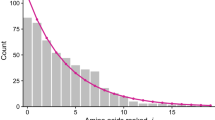Abstract
New equations are derived to estimate the number of amino acid substitutions per site between two homologous proteins from the root mean square (RMS) deviation between two spatial structures and from the fraction of identical residues between two sequences. The equations are based on evolutionary models, analyzing predominantly structural changes and not sequence changes. Evolution of spatial structure is treated as a diffusion in an elastic force field. Diffusion accounts for structural changes caused by amino acid substitutions, and elastic force reflects selection, which preserves protein fold. Obtained equations are supported by analysis of protein spatial structures.
Similar content being viewed by others
References
Barry D, Hartigan JA (1987) Asynchronous distance between homologous DNA sequences. Biometrics 43:261–276
Chotia C, Lesk A (1986) The relation between the divergence of sequence and structure in proteins. The EMBO J 5:823–826
Dayhoff MO, Eck RV, Park CM (1972) A model of evolutionary change in proteins. In: Dayhoff MO (ed) Atlas of protein sequence and structure, 5. National Biomedical Research Foundation, Washington, DC, pp 89–99
Dayhoff MO, Schwartz RM & Orcutt BC (1978) A model of evolutionary change in proteins. In: Dayhoff MO (ed) Atlas of protein sequence and structure, 5, Suppl 3. National Biomedical Research Foundation, Washington, DC, pp 345–352
Flores TP, Orengo CA, Moss DS, Thornton JM (1993) Comparison of conformational characteristics in structurally similar protein pairs. Protein Science 2:1811–1826
Grishin NV (1995) Estimation of the number of amino acid substitutions per site when the substitution rate varies among sites. J Mol Evol 41:675–679
Gutin AM, Badretdinov AY (1994) Evolution of protein 3D structures as diffusion in multidimensional conformational space. J Mol Evol 39:206–209
Holmquist R, Goodman M, Conroy T, Czelusniak J (1983) The spatial distribution of fixed mutations within genes coding for proteins. J Mol Evol 19:437–448
Hubbard TJP, Blundell TL (1987) Comparison of solvent-inaccessible cores of homologous proteins: definitions useful for protein modeling. Protein Engineering 1:159–171
Kishino H, Miyata T, Hasegawa M (1990) Maximum likelihood inference of protein phylogeny and the origin of chloroplasts. J Mol Evol 31:151–160
Lesk AM, Chotia CH. (1986) The response of protein structure to amino-acid sequence changes. Phil Trans R Soc Lond A 317:345–356
Olsen GJ (1987) Earliest phylogenetic branchings: comparing rRNAbased evolutionary trees inferred with various techniques. Cold Spring Harbor Symposia on Quantitative Biology 52:825–837
Ota T, Nei M (1994) Estimation of the number of amino acid substitutions per site when the substitution rate varies among sites. J Mol Evol 38:642–643
Rzhetsky A, Nei M. (1992) A simple method for estimating and testing minimum-evolution trees. Mol Biol Evol 9:945–967
Saitou N (1988) Property and efficiency of the maximum likelihood method for molecular phylogeny. J Mol Evol 27:261–273
Takacs L. (1966) Stochastic process. Methuen & Co LTD, London, John Wiley & Sons Inc., NY
Tajima F, Takezaki N (1994) Estimation of evolutionary distance for reconstructing molecular phylogenetic trees. Mol Biol Evol 11:278–286
Tateno Y, Takezaki N, Nei M. (1994) Relative efficiencies of the maximum-likelihood, neighbor-joining, and maximum-parsimony methods when substitution rate varies with site. Mol Biol Evol 11:261–277
Uzzel T, Corbin KW (1971) Fitting discrete probability distribution to evolutionary events. Science 172:1089–1096
Wilbur WJ (1985) On the PAM matrix model of protein evolution. Mol Biol Evol 2:434–447
Yang Z (1993) Maximum-likelihood estimation of phylogeny from DNA sequences when substitution rates differ over sites. Mol Biol Evol 10:1396–1401
Yang Z (1994) Maximum likelihood phylogenetic estimation from DNA sequences with variable rates over sites: approximate methods. J Mol Evol 39:306–314
Zharkikh A (1994) Estimation of evolutionary distances between nucleotide sequences. J Mol Evol 39:315–329
Zuckerkandl E, Pauling L. (1965) Evolutionary divergence and convergence in proteins. In: Bryson V, Vodel HJ (eds) Evolving genes and proteins. Academic Press, NY, pp 97–166
Author information
Authors and Affiliations
Rights and permissions
About this article
Cite this article
Grishin, N.V. Estimation of evolutionary distances from protein spatial structures. J Mol Evol 45, 359–369 (1997). https://doi.org/10.1007/PL00006241
Received:
Accepted:
Issue Date:
DOI: https://doi.org/10.1007/PL00006241




